Electrical Conduit
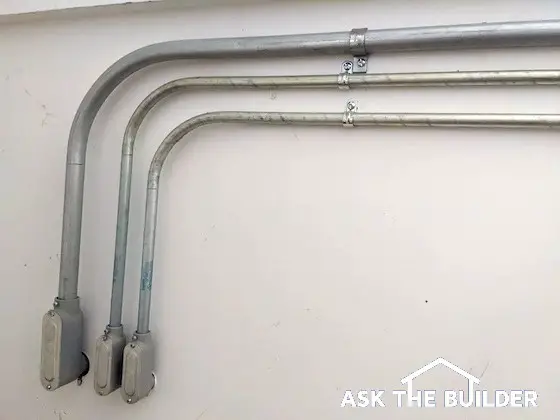
Electrical Conduit - This is typical electric conduit. It's steel pipe that's easy to bend. This conduit is in my garage and was added after my house was built. The steel tubes contain wires that connect my standby generator outside to the electric panels in my basement.
Electrical Conduit - Should You Install It in Your Home?
Before I jump into this topic about electric conduit, I feel you need to know a little history about how my media and influencer profession works.
Ask the Builder started out as a syndicated newspaper column in October of 1993. In fact, as of June 2022, it still runs in over 60 papers in the USA.
Within a few months of the birth of my new profession, I started to hear from public relations (PR) professionals. As I was a college-trained geologist then carpenter/plumber/builder, I had no idea about this profession nor how it worked.
It took a few years for me to wake up and realize what was happening. Much of it involves powerful psychology that's used to persuade and manipulate writers and influencers like me. Perhaps the best book you can read to discover how you're being played like a fiddle each day in your life about everything is Influence - The Psychology of Persuasion.
PR pros often offer up free products to writers and influencers so they can test the products. Writers and influencers are often invited on all-expenses-paid press junkets. Manufacturers who fund these editors conferences have a captive audience to share their message. The attendees are treated to great hotels, delicious food, liquid refreshment of all types, and often interesting entertainment.
I'll never forget eating dinner on white tablecloths inside a quiet Atlanta museum rented out just for us. Building a two-man boat out of cardboard with other home improvement editors in a competition at a Florida resort swimming pool is tattooed in my tiny gray cells. Yes, my team won going back and forth across the pool in record time without sinking because our leader, Larry Eisinger, happened to be an avid boater and expert model maker.
All of the above pushes the reciprocity button in writers, editors, and influencers. Once you accept a gift, accept a piece of cheese on a toothpick at a grocery store from a nice older woman in an apron, a neighbor lends you a tool, or a PR person gives you something you don't need to return, you automatically feel obligated to do something in return. It's basic human behavior. Read about this, and the even more powerful psychological buttons, in the above book.
Two of these PR pros became really good friends over my career and are the best I've ever met: Laura Bennett and Kathy Ziprik. Most PR people I've interacted with over the years couldn't lace Laura and Kathy's boots.
There's an old adage in the newspaper business: News is what people don't want you to print. Everything else is advertising (PR).
This column was inspired by a professional PR person tasked (paid) to get the word out about electrical conduit pipe and electrical conduit fittings. She was hired by the Steel Tube Institute (STI).
Why did this PR pro reach out to me? My guess is it was her hope I'd do what so many of my peers do. Many take a short cut and simply regurgitate the information contained in her well-written press release. The problem is her press release contained just part of the truth about metal conduit. The STI controlled what was in the press release as they're paying for the work.
My job as a columnist is to tell you the whole story about a topic. I've been an expert witness for over 23 years and we have a saying in our business: A half-truth is a whole lie.
Let's unpack the facts about electrical conduits, especially metal electrical conduit. Allow me to share with you everything I know about the cables and wires in your home and how they can be installed.
Electrical Conduit Pipe - What is It and Why is it Used?
Electrical conduit is a tube through which electrical wires pass. Steel is cheap, it's strong, and it does an amazing job of protecting the energized conductors within the conduit. This is why the National Electrical Code (NEC) specifies that conduit must be used in just about all commercial, institutional, manufacturing, and non-residential electric installations. You don't want wires carrying current to get damaged easily. When this happens people can get electrocuted and fires can start.
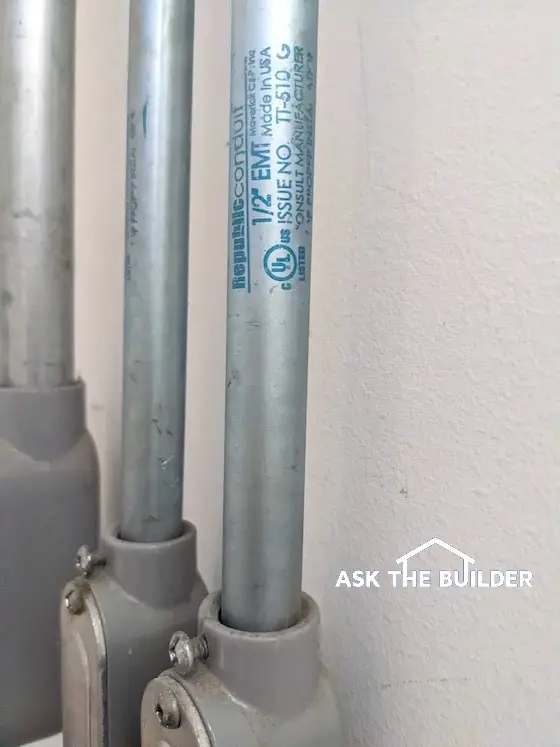
This is a closeup of the metal electrical conduit in my garage. You can see the stamping on the tubing indicating it meets the NEC.
Is Conduit for Electrical Wire Required in Homes?
Conduit is required in residential homes in some areas. Local unions and building/electrical inspectors that have been co-opted by friends in the industry can dictate how electric cables and wires are installed in your home.
They can ignore safe and proven installation practices and products that are approved in the NEC.
If you live in Chicago, Illinois your electric wires will pass through conduit. The Steel Tube Institute would love to see it required in every home. They have a dog in the fight for goodness sake. The STI pays people to promote its products as do many many many manufacturers. Some manufacturers lobby the people who create the NEC as well as the building code.
Never forget that everything in your life and mine is a real-time mirror image of the Game of Thrones. Everything revolves around money, power, and sex for most people.
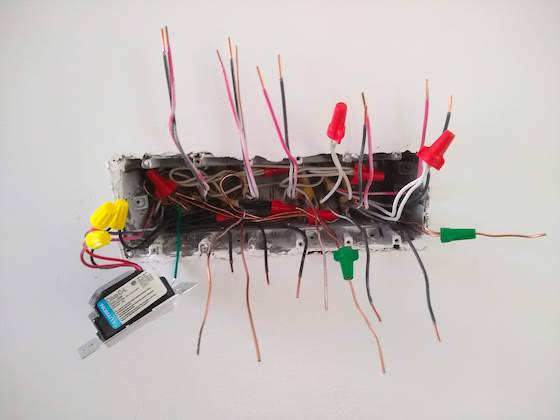
How many pieces of conduit would have to feed into this six-gang switch box to make all this magic happen? There are twelve Romex NM-B cables feeding into and out of this box to make the six 3 and 4-way switches work. Imagine what needs to be done so twelve different steel tubes don't interfere with one another. How much skill does that require?
What is Used to Install Wiring if Conduit is Not Used?
Non-metallic sheathed cable is what is used instead of conduit. Most tradespeople and suppliers call it Romex or NM-B. This type of wiring is used in probably 99.995% of the homes built in the USA. I've installed many miles of it in my lifetime. When installed according to the guidelines in the NEC, Romex is exceedingly safe. The statistics provided by the National Fire Protection Agency (NFPA) support this fact.
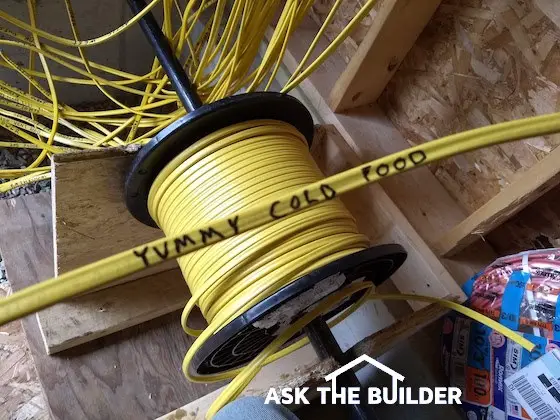
This is non-metallic sheathed cable NM-B or Romex wiring. Its yellow plastic outer covering tells you the conductors inside are 12 gauge rated for 20 amps. The cables in the upper left of the photo lead to separate circuits in my daughter's new home. The writing on each cable allows you to identify each circuit breaker within the electric panel on the wall. Can you guess where the cable that says YUMMY COLD FOOD terminates inside the house? Copyright 2022 Tim Carter ALL RIGHTS RESERVED
The multi-billion-dollar insurance industry is behind the curtain of the NFPA who curates the National Electrical Code. If huge insurance companies thought that Romex was too great an insurable risk, rest assured Romex would be PROHIBITED in the NEC.
It's not prohibited. That should put your head on a swivel.
How Much Extra Does it Cost to Install Electrical Conduit?
It costs much more money to install electrical conduit than Romex.
I asked the PR woman hired by the STI how much conduit is required in an average-sized home in the USA. She deferred to Dale Crawford, the executive director of the STI. His response was: "A 2,333 square foot home (average new construction in US in 2020) would need between 4,500 and 4,800 linear feet of conduit. "
I then asked, what is the added labor cost in the average home to install the steel tubing/conduit? Dale deftly replied, "This is highly variable, which makes it difficult to estimate. Skilled union labor can install conduit nearly as fast as installing NM-B. The union electricians in Chicago are especially skilled and impressive at this."
Unfortunately that's not the answer I was looking for. I'll explain below the extra labor that's required to install conduit vs Romex or NM-B cable.
I also asked, what is the price-per-foot of the three needed THHN conductors that would run in the steel tube? Dale was polite and quick to point out that my question contained an error. I had forgotten that the steel conduit takes the place of the bare ground wire that the NEC requires in NM-B cable. In other words, when you remove the plastic sheathing in NM-B cable, you'll discover three conductors: the white wire that's neutral, the black wire that's hot, and a bare wire that goes to ground.
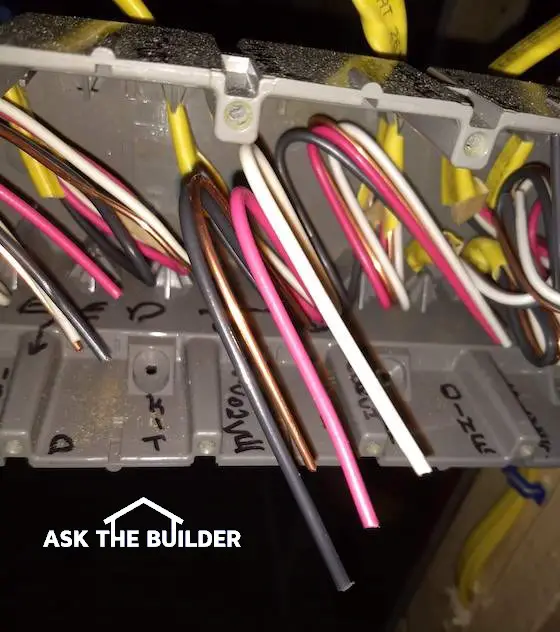
This is what the wires look like inside Romex or NM-B cable. In this case, the extra red wire helps make it easy to connect 3 and 4-way switches. This special cable can also carry two separate circuits to one junction box. It can also be used to create a 240-volt circuit. It's all quite confusing if you're not up to speed with the NEC.
He said, "Here is where one of the big cost comparison adjustments comes in, especially given the benefits of protection of conduit. Only two conductors would be required for this installation in conduit, as a ground is not needed or required by code. The steel conduit acts as the equipment grounding conductor in this installation, saving about 33% of the cost of wiring. Two 14 AWG conductors would be $0.15/foot and 12 AWG would be $0.20/foot, roughly." (May 2022 pricing)
What is Needed to Install Metal Electrical Conduit?
When you decide to use metal conduit in lieu of Romex or NM-B cable, you need the following:
- metal tubing
- metal boxes
- metal extension rings
- electrical conduit fittings
- THNN plastic-coated wires
That's pretty much what's required.
What is Needed to Install Romex or NM-B Cable?
You need the following to install Romex or NMB cable to NEC standards:
- Romex or NM-B cable that contains three wires
- plastic boxes
- cable staples
Wire nuts are required in both installations so I left them out of both lists.
What's the Cost Comparison for Both Material Lists?
You might want to sit down for this.
Let's look at electric conduit first. This is not an all-inclusive cost analysis because each installation is different and requires a different number of parts. All prices were checked on June 5, 2022 at the Lowe's website.
- 1/2-inch x 10 feet EMT steel conduit - $6.98 per length
- standard 4x4 metal box - $2.58 each
- standard set screw conduit connector (you need hundreds of these for one house) - $1.48 each
- 1/2-inch extension ring - $1.58 each
- THHN wire 14 gauge - $0.17 per foot - NOTE: You need two wires - white/black - in each piece of conduit so figure $0.34 per foot
Now let's look at the cost for Romex/NMB materials:
- 2x3 plastic box - $1.08
- cable staples - pack of 500 - $13.02
- 14/2 WG Romex cable in 250-foot roll - $0.50 per foot
Summary: Each separate box where you might have a single outlet or wall switch will cost you $5.64 should you use conduit. Each separate single-gang box for Romex/NM-B will cost you about $1.11 including a cable staple or two. An average home could have at least 100 boxes. Thus, using conduit, you'll spend about $450.00 more just for the boxes.
The wire price is quite close as each conductor in the Romex roll is costing you $0.165.
The price of the conduit, based on Dale's estimate, is $3,245.70. You don't need any conduit with a Romex/NMB installation
What Extra Labor is Required to Install Conduit?
Here are the extra steps required to install electrical conduit:
- install the set screw connectors and any couplers for long runs of conduit
- measure and bend the conduit
- install the conduit
- install the extension ring
Installing the cables/wires in both methods is probably a wash. With Romex/NM-B you just pull the wires through the drilled holes. With conduit, the electrician needs to pull the wires through using a pull cord he blew threw the pipe or maybe he uses a fish tape.
What is the extra cost to do the extra steps for the steel conduit? You can bet it's thousands of dollars with the current labor rate (2022) of about $95 per hour for a master electrician.
BOTTOM LINE: If you decide to use electrical conduit in your new home, you can expect to pay a $6,000 - 7,000 premium for it in 2022 dollars. When I reached out to the NFPA PR contact about hard statistics that steel conduit will significantly reduce the amount of electrical fires in a home, she never got back with me.
Here's a fact: There are many millions of homes in the USA that have non-metallic sheathed wiring in them. These are decades and decades old some actually have first-generation knob and tube wiring. The vast majority of these homes have never had a fire caused by approved Romex or NM-B cable.
One Response to Electrical Conduit